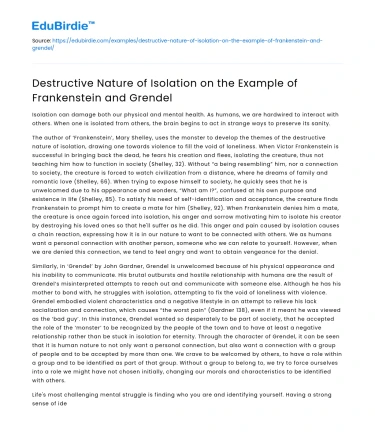Isolation can damage both our physical and mental health. As humans, we are hardwired to interact with others. When one is isolated from others, the brain begins to act in strange ways to preserve its sanity.
The author of ‘Frankenstein’, Mary Shelley, uses the monster to develop the themes of the destructive nature of isolation, drawing one towards violence to fill the void of loneliness. When Victor Frankenstein is successful in bringing back the dead, he fears his creation and flees, isolating the creature, thus not teaching him how to function in society (Shelley, 32). Without “a being resembling” him, nor a connection to society, the creature is forced to watch civilization from a distance, where he dreams of family and romantic love (Shelley, 66). When trying to expose himself to society, he quickly sees that he is unwelcomed due to his appearance and wonders, “What am I?”, confused at his own purpose and existence in life (Shelley, 85). To satisfy his need of self-identification and acceptance, the creature finds Frankenstein to prompt him to create a mate for him (Shelley, 92). When Frankenstein denies him a mate, the creature is once again forced into isolation, his anger and sorrow motivating him to isolate his creator by destroying his loved ones so that he'll suffer as he did. This anger and pain caused by isolation causes a chain reaction, expressing how it is in our nature to want to be connected with others. We as humans want a personal connection with another person, someone who we can relate to yourself. However, when we are denied this connection, we tend to feel angry and want to obtain vengeance for the denial.
Save your time!
We can take care of your essay
- Proper editing and formatting
- Free revision, title page, and bibliography
- Flexible prices and money-back guarantee
Similarly, in ‘Grendel’ by John Gardner, Grendel is unwelcomed because of his physical appearance and his inability to communicate. His brutal outbursts and hostile relationship with humans are the result of Grendel’s misinterpreted attempts to reach out and communicate with someone else. Although he has his mother to bond with, he struggles with isolation, attempting to fix the void of loneliness with violence. Grendel embodied violent characteristics and a negative lifestyle in an attempt to relieve his lack socialization and connection, which causes “the worst pain” (Gardner 138), even if it meant he was viewed as the ‘bad guy’. In this instance, Grendel wanted so desperately to be part of society, that he accepted the role of the ‘monster’ to be recognized by the people of the town and to have at least a negative relationship rather than be stuck in isolation for eternity. Through the character of Grendel, it can be seen that it is human nature to not only want a personal connection, but also want a connection with a group of people and to be accepted by more than one. We crave to be welcomed by others, to have a role within a group and to be identified as part of that group. Without a group to belong to, we try to force ourselves into a role we might have not chosen initially, changing our morals and characteristics to be identified with others.
Life's most challenging mental struggle is finding who you are and identifying yourself. Having a strong sense of identity seems to be desirable among people, bringing comfort and security. Lonely isolated people who struggle with an identity crisis often act out in order to try to establish their role within a relationship. As seen in both characters, Frankenstein and Grendel, isolation leads to emotional pain caused by isolation, thus leading to violence as a result of attempting to define one’s character and niche in both a personal relationship and a group relationship. Therefore, one who is not comfortable with themselves due to their environment will lead to a change in their identity which results in negative consequences and violence.






 Stuck on your essay?
Stuck on your essay?

